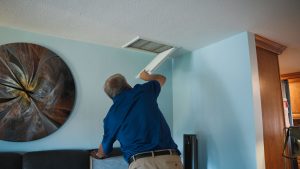When most Florida homeowners think about air conditioning maintenance, duct cleaning usually isn’t the first thing that comes to mind. But keeping your air ducts clean is just as important as changing your filters or scheduling a regular tune-up. Clean air ducts can help AC systems run better, improve indoor air quality, and reduce energy bills. It can even possibly help you avoid the need for air conditioning repair in Manasota Key. Keep reading to learn more about this important service.
Bayonet Plumbing, Heating & Air Conditioning Blog: Archive for the ‘Indoor Air Quality’ Category
Ventilation: The “V” in HVAC and Why It’s Essential
Monday, June 23rd, 2025When people think of HVAC systems, the focus is usually on heating (the “H” in HVAC) and air conditioning (the AC). However, your home’s ventilation system (also referred to as ductwork or air ducts) is an important component. In fact, that’s what the “V” in HVAC stands for. At Bayonet Plumbing, Heating & Air Conditioning, we want Florida homeowners to know that keeping your ventilation system clean is essential not just for your AC’s performance but for your home’s air quality as well.
What’s Hiding in Your Air Ducts? The Case for Duct Cleaning
Monday, June 16th, 2025At Bayonet Plumbing, Heating & Air Conditioning, we believe your home should be a safe, healthy space, especially when it comes to the air you breathe. But have you ever stopped to think about what might be lurking inside your air ducts? If not, you’re not alone. Most homeowners don’t give their ductwork a second thought until they start noticing musty odors, dust buildup, or allergy flare-ups. The truth is, your air ducts might be harboring more than you’d expect, and those hidden contaminants can have a big impact on your indoor air quality, your health, and your HVAC system’s performance. Read on to learn about the benefits of duct cleaning.
How Your Ductwork Supports Your AC System
Monday, June 16th, 2025At Bayonet Plumbing, Heating & Air Conditioning, we often get questions about how to improve air conditioning efficiency, especially as Florida’s hot and humid months roll in. Most people think of their AC unit as the star of the show—and it certainly plays a big role. But there’s an unsung hero that deserves just as much attention: your ductwork.
Your duct system is the highway that delivers cooled air throughout your home. If that highway is poorly designed, leaking, or dirty, your air conditioner will have to work overtime just to keep you comfortable and could eventually lead to the need for air conditioning repair in Clermont. In this post, we’ll break down how your ductwork supports your AC system and why maintaining it is key to comfort, efficiency, and savings.
The Vital Role That Ventilation Plays in AC System Performance
Monday, June 16th, 2025When most homeowners think of HVAC systems, their attention usually lands on the heating and air conditioning components. But there’s one critical piece of the puzzle that often goes unnoticed: ventilation—the “V” in HVAC. At Bayonet Plumbing, Heating & Air Conditioning, we believe that great cooling starts with proper airflow. Without it, even the most advanced air conditioner can underperform, waste energy, and leave you uncomfortable in your own home. Let’s take a closer look at what ventilation is and why it’s essential to the performance and efficiency of your AC system.
Does Ductwork Really Need to Be Cleaned?
Monday, June 16th, 2025When it comes to home maintenance, tasks such as changing air filters and scheduling AC tune-ups tend to receive the most attention. But what about your ductwork—the hidden network that delivers heated or cooled air to every room in your home? Is duct cleaning really necessary for your home comfort?
At Bayonet Plumbing, Heating & Air Conditioning, we believe the short answer is: yes, ductwork does need to be cleaned—just not every year. And when it’s done right, it can make a noticeable difference in your indoor air quality, HVAC efficiency, and comfort. Let’s explore why, how often, and under what conditions your home’s ductwork should be cleaned.
How Indoor Air Quality Services Create a Healthier Home
Monday, June 9th, 2025When we think about comfort at home, temperature is usually the first thing that comes to mind. But there’s another invisible factor that plays a huge role in your health, energy levels, and even your home’s condition: indoor air quality (IAQ). At Bayonet Plumbing, Heating & Air Conditioning, we’ve seen firsthand how overlooked air quality issues can impact Florida homes and how the right solutions can dramatically improve daily life. Contact us if you’re looking for an air conditioning company in Lake Wales that can make your home more comfortable.
The Benefits of a Whole-Home Dehumidifier for Indoor Air Quality
Monday, June 9th, 2025When it comes to home comfort, temperature isn’t the only factor at play. In Florida, where humidity levels are often sky-high, excess moisture in the air can have serious consequences, not just for how your home feels, but for your health and your home’s structure. At Bayonet Plumbing, Heating & Air Conditioning, we know firsthand how high indoor humidity can create hidden problems. That’s why we are an air conditioning company in South Venice that offers indoor air quality (IAQ) services that target the source and help you breathe easier.
Is My Home Too Humid?
Monday, June 9th, 2025As an air conditioning company in Beverly Hills, we get this question all the time: “Is my home too humid?” If you’re feeling sticky indoors even with the air conditioning on, noticing musty smells, or spotting mold around your vents, chances are the humidity in your home is higher than it should be.
While your central air conditioner does help reduce some humidity, it’s not designed to keep indoor moisture at optimal levels. If your home often feels damp, clammy, or muggy, it’s time to look beyond the AC and consider a whole-house solution.
Why Indoor Humidity Levels Matter
Monday, June 9th, 2025Florida’s tropical climate is part of what makes our state so beautiful, but it also brings high humidity levels that can wreak havoc on your indoor air quality. If your home constantly feels muggy, musty, or you’re battling mold and allergens, the culprit is likely excess humidity. Fortunately, there’s a reliable, long-term solution: a whole-home dehumidifier. Let’s explore how maintaining ideal indoor humidity levels can transform your comfort and your health and why Bayonet is the air conditioning company in Bradenton you should call when you want to do something about it.






